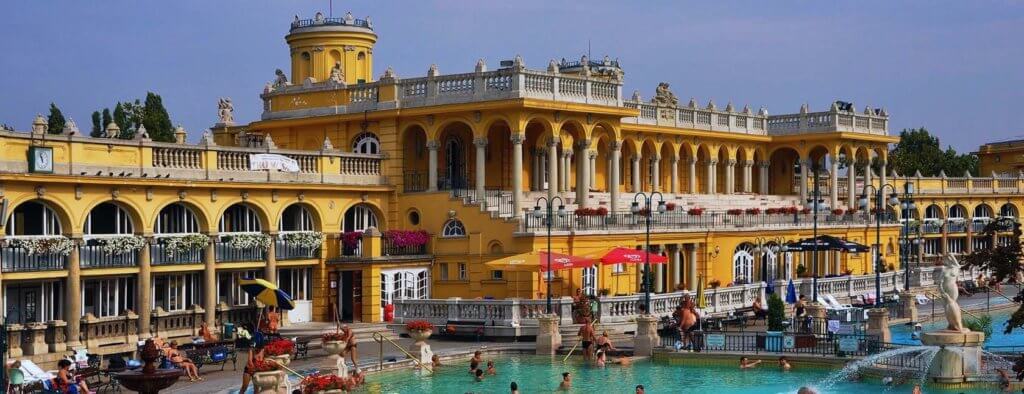Body and soul recharge in the Szechenyi Thermal Bath

Budapest’s spa town – our capital has been deserving of this because most of the thermal springs and spa are located here, which offer a unique experience for visitors to the Hungarian capital both from a historical point of view and from a recreational point of view.
In addition to the water culture of the Hungarians, in the creation and development of this special value, many of the conquering peoples of history that have been invaded in history also played a major role. Therapeutic tourism is one of the most important tourism sectors in Budapest, where the city’s spa and thermal baths are of great importance.
If you want to be part of truly special wellness experience, choose your relaxation location as one of Budapest’s largest spa complexes. You are waiting for the Széchenyi Thermal Bath, in the heart of the capital, in the embrace of the Városliget.

The thermal baths and spa services of Széchenyi Spa in Budapest, known as the “Szecska” nickname, guarantee guaranteed refreshment for both Hungarian and foreign visitors all year round.
The unique spa complex has a total of 21 swimming pools, including an outdoor pool, swimming pool, spa, and indoor pool. The thermal spa, the thermal bath, the sludge treatment, the weight bath, the hot tub bath, the medical massage, the underwater jet massage or the underwater group gymnastics all contribute to the complete satisfaction of the services of the Széchenyi Thermal Bath. In addition to the spa and wellness services, there is a light and aroma sauna, a steam bath, a steam room, a gym, and an aerobics room.

Whether you are planning a family or romantic getaway, the Széchenyi Thermal Bath in Budapest offers a pleasant stay for everyone.
Experience pools offer great relaxation for children and families, outdoor and indoor swimming pools are waiting for sports and movement lovers regardless of the season. Maximum relaxation and unobtrusive entertainment are guaranteed – this is a swim corridor built in the pool, underwater whirlpool, neck shower and water jets hidden in the seat pads.
The spa offers a variety of program opportunities – there are regular opportunities for bathing in night-time events, as well as habitats especially frequented by younger people.
The Sparty series of events in the Szechenyi Thermal Spa has been one of Budapest’s most visited and celebrated events in the past decades, with its annual 50-55 thousand visitors and its continuous development. The program is visited not only by Hungarian guests but also by tourists from abroad. Due to the outstanding interest, “every weekend, the young people who want to have fun entertain the spa, where pleasant thermal water, visual effects, and high-quality electronic music provide a pleasant and pleasant get-away. This also proves that Széchenyi Thermal Bath’s style, elegance, and services provide an opportunity for leisure and recreation for ages and thousands of years for all ages.


Szechenyi Thermal Bath
The Széchenyi Thermal Baths of Budapest are not only famous for its thermal water but also it’s castle-like, eye-catching building, with its impressive neo-baroque building in the center of Városliget. One of the emblematic attractions of Budapest, a popular destination for tourists to the city. The building’s interest is that the model made of it represented our country at the Mini Europe fashion exhibition in Brussels.
Pest’s first spa, the Szechenyi Thermal Bath was created by Vilmos Zsigmondy. The mining engineer initiated the deep drilling in the Városliget, which proved to be successful, and in 1881 the spa bath of the calcium-magnesium-hydro carbonate spa was opened under the name of “Artézi Bath” until the opening of the Szechenyi Bath. Since Bath Artézi was less and less able to serve the needs of the age, the Széchenyi Spa was built according to the plans of György Czigler, whose bath parts and the building itself have undergone numerous renovations and enlargements during the 1900s.
During the enlargements, male and female populace baths, as well as a beach bath, were established, later in the 1960s a thermal department and a complex physiotherapy class were housed in the building. In 1963, the dressing rooms of the beach bath were paved, which since the completion of the works the outdoor swimming pools have been operating in winter.
After the opening, the popularity of the bath grew rapidly. In 1919 he received approximately 900,000 guests. His unpopular popularity and the need for bathing in the ever-widespread and popular way of bathing made the spa’s development indispensable. In August 1927, the baths of the spa bath were completed, as well as a spa bath





